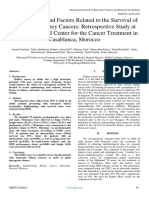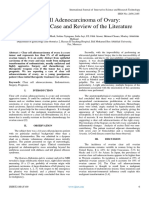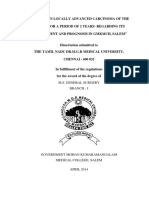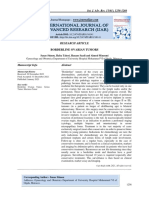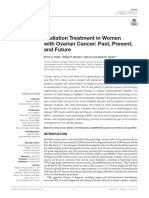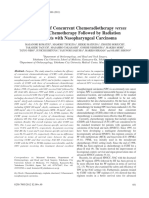Professional Documents
Culture Documents
Uterine Carcinosarcoma A Rare and Challenging Cancer
0 ratings0% found this document useful (0 votes)
12 views3 pagesUterine carcinosarcoma is a rare and highly
aggressive malignancy
Original Title
Uterine Carcinosarcoma a Rare and Challenging Cancer
Copyright
© © All Rights Reserved
Available Formats
PDF, TXT or read online from Scribd
Share this document
Did you find this document useful?
Is this content inappropriate?
Report this DocumentUterine carcinosarcoma is a rare and highly
aggressive malignancy
Copyright:
© All Rights Reserved
Available Formats
Download as PDF, TXT or read online from Scribd
0 ratings0% found this document useful (0 votes)
12 views3 pagesUterine Carcinosarcoma A Rare and Challenging Cancer
Uterine carcinosarcoma is a rare and highly
aggressive malignancy
Copyright:
© All Rights Reserved
Available Formats
Download as PDF, TXT or read online from Scribd
You are on page 1of 3
Volume 6, Issue 5, May – 2021 International Journal of Innovative Science and Research Technology
ISSN No:-2456-2165
Uterine Carcinosarcoma:
A Rare and Challenging Cancer
Hassani Wissal,Farhan Fatim-zahra,Alami Zenab,Bouhafa Touria
HASSAN II hospital,
Fez, Morocco
Abstract:- Uterine carcinosarcoma is a rare and highly III. RESULTS
aggressive malignancy.[1] The prognosis is often poor.
The clinical presentation of the uterine carcinosarcomas is A total of 13 patients were carried for a uterine
nonspecific, and imaging and pathology studies play an carcinosarcoma in the radiotherapy department of the Hassan
important role in diagnosis.[2] In this study, we are II hospital in Fez between January 2017 and December 2020.
exposing the clinical, paraclinical and therapeutic aspects The median age was 62 year-old [56-80]. Great multiparity
of patients with uterine carcinosarcoma treated in the was found in 75% of cases. All of our patients were
radiotherapy department of Hassan II university hospital postmenopausal and the median time from menopause to
center, and discuss our results with literature data. diagnosis was 13 years. The most common medical issues
were diabetes and blood pressure. 89% of our patients had a
Keywords:- Carcinosarcoma, Diagnosis, Management. body mass index (BMI) ≥30.
I. INTRODUCTION The median delay for condultation was 6 months. Post-
menopausal bleeding was major symptom for consultation.
Uterine carcinosarcomas is considered as rare tumor. It The gynecological examination found an increased in uterus
counts for less than 5% of uterine malignancies. It is size in 80% of cases. A Magnetic resonance imaging (MRI)
considered as high-risk form of endometrial was performed and found a bulky endocavitary mass in hypo-
adenocarcinoma[1]that got similitudes with endometrial intense in the T1 and T2-weighted sequences.
carcinoma more than with uterine sarcomas(epidemiology,
risk factors, clinical behavior).[1] The standard management A diagnostic hysteroscopy with biopsy dissection was
of carcinosarcomas consist in surgical staging [2] the performed in 80% of cases that found out carcinomatous or
indication of adjuvant treatment (chemotherapy, radiotherapy sarcomatous process with a heterologous component in 75%
and brachytherapy), depends on histological stage.[4] of cases. After the confirmation of the diagnosis, patients
went CT to eliminate the presence of metastases. 40% of the
We aimed in our study to expose clinical, paraclinical patients were classified as stage IB, stage II in 20% of cases,
and therapeutic aspects of patients with uterine stage IIIC1 and IVB in 20% of cases.
carcinosarcoma treated in the radiotherapy department of
Hassan II university hospital center. The surgical management consisted on total abdominal
hysterectomy, bilateral salpingo-oophorectomy and
II. PATIENTS AND METHOD retroperitoneal lymph node dissection. 40% of the patients
were classified as stage IB, stage II in 20% of cases, stage
It is a retrospective study carried out in the radiotherapy IIIC1 and IVB in 20% of cases.
department of Hassan II hospital in Fez between January
2017 and December 2020 on women presenting an uterine Adjuvant therapy was offered for all patients. They all
carcinosarcomas. All of our patients were over 18 years old went through chemotherapy (cisplatin regimen and taxanes),
and had a diagnosis of carcinosarcoma confirmed by External beam radiotherapy (EBRT) and received 50Gy in
pathological examination. The patients were listed via the 28 fractions and endocavitary HDR brachytherapy.
service register and the data collected on the basis of hospital
network [HOSIX] and paper file of each patient. The data After a median follow-up of 18 months, 70% of our
was entered and analyzed by the epi-info software version women were in remission, 10% in recurrence, and 10% in
3.5.2011. metastatic event.
IJISRT21MAY714 www.ijisrt.com 1356
Volume 6, Issue 5, May – 2021 International Journal of Innovative Science and Research Technology
ISSN No:-2456-2165
IV. DISCUSSION Uterine carcinosarcoma usually requires combined
modality approach which includes surgery, chemotherapy,
Uterine carcinosarcoma accounts for 4.3% of all uterine radiotherapy and sometimes hormonal therapy. Surgery
corpus cancers. The worldwide annual incidence is 0.5–3.3 includes hysterectomy, bilateral salpingoophrectomy, lymph
cases per 100,000 women[5]. This incidence is increasing at node dissection and resection of all gross disease. The
approximately 50 years of age and reaches a maximum at the decision of an adjuvant treatment after surgery has to be
age of 75 years[6]. The median age at the time of diagnosis is individualized depending on the staging at diagnosis and
62-67 years[2] which corresponds to the results found in our condition of the patient. Patients with stage I and II are
series. usually treated by total abdominal hysterectomy, bilateral
salpingoophrectomy and omentectomy also performed
The most commonly associated etiological factors of because of the probability of abdominal dissemination.
carcinosarcoma are previous exposure to radiation. [10] The Patients may need adjuvant radiotherapy and chemotherapy.
frequency of carcinosarcoma after radiation exposure For patients with advanced stages (III, IV), they can be
increased from a baseline rate as expected. It has been offered debulking surgery, chemotherapy, and adjuvant
suggested that post-irradiation carcinosarcoma occur at a radiation.
younger age than those arising de novo. [11] The common
risk factors associated with the development of Adjuvant irradiation is usually associated to a better
carcinosarcoma are exposure to tamoxifen, exogenous local control, and is indicated for women with early-stage
estrogen and obesity.[3].In our series 89% of the patients had carcinosarcoma completely resected.[4] A randomized trial
a BMI corresponding to a state of obesity. demonstrated that adjuvant radiotherapy on the pelvis (total
dose of 50.4 Gy) in early stage disease ( I or II ) improved
The common symptoms of uterine carcinosarcomas are local control in the subgroup for women with
vaginal bleeding and pain associated to rapidly growing carcinosarcoma.[12]
uterus. Vaginal bleeding is the most frequent symptom.[3]
Usually, pelvis examination finds a growth that can be Patients presenting a carcinosarcoma of the uterus
palpated or seen through the cervical os. Almost 15% of should be closely followed up considering the state of
patients present an involvement of the cervix identified disease, in fact, a high risk of local recurrence (60%) and
through cervical biopsy, endocervical curettage, or both [7] distant metastasis has been reported; [1] Guidelines for the
A computed tomography (CT) scan or gadolinium- follow up are identical to those for women treated for
enhanced magnetic resonance imaging (MRI) are requested endometrial adenocarcinoma. Clinical follow-up should be
for evaluating extention of disease locally. It usually finds an performed with a physical exam, and vaginal cytology i every
heterogeneous bulky polypoid prolapsing into the 3 months for 2 years, then every 6 months for 5 years[13]
endocervical canal and can also find a prolonged intense
enhancement .[8]. The behavior of carcinosarcomas is Due to its aggressive behavior, the overall prognosis of
governed by the carcinomatous element. Carcinoma usually uterine carcinosarcoma is poor, even with the best of care,
metastasizes through the lymphatic channels to nearby lymph [14]Staging is considered as the most important prognostic
nodes, while sarcoma usually metastasizes to peritoneal factor. Other factors described are patient age, and presence
cavity or to the lungs. In sarcoma, lymph node metastasis is of gross residual disease[15]
very uncommon. The patients of carcinosarcomas behave
much like as high grade endometrial adenosarcoma and V. CONCLUSION
commonly metastasize to pelvic or par aortic lymph nodes[9]
Carcinosarcoma is considered as a rare but particularly
The histological examination allows confirming the aggressive uterine cancer. A multidisciplinary management
diagnosis. It finds 2 populations: carcinomatous and is useful including complete surgical staging and multimodal
sarcomatous cells with invasion of the stroma. Thus, the therapy combining external beam irradiation or vaginal
diagnosis is based on histopathology of the hysterectomy brachytherapy and systematic chemotherapy in patients with
piece. In fact, surgery is considered as primary management both early and advanced stage disease. However, the rarity of
for carcinosarcoma. It allows staging and initial treatment[10] this disease is an obstacle to the implementation of large
Uterine carcinosarcoma staging is as stated on 2017 randomized trials to allow adequate assessment and better
International Federation of Gynecology and Obstetrics management.
(FIGO)/Tumor, Node, Metastasis (TNM) classification
system.
Because this cancer is aggressive compared to other
uterine cancers, screening for an early efficient diagnosis and
choosing the correct management strategy have an extreme
significance. Treatments of this neoplasm usually use
surgery, irradiation therapy, and chemotherapy.
IJISRT21MAY714 www.ijisrt.com 1357
Volume 6, Issue 5, May – 2021 International Journal of Innovative Science and Research Technology
ISSN No:-2456-2165
REFERENCES [14]. Harano K, Hirakawa A, Yunokawa M, Nakamura T,
Satoh T, Nishikawa T, et al. Prognostic factors in
[1]. Cantrell LA, Blank SV, Duska LR. Uterine patients with uterine carcinosarcoma: a multi-
carcinosarcoma: A review of the literature. Gynecol institutional retrospective study from the Japanese
Oncol. 2015;137(3):581–588. Gynecologic Oncology Group. Int J Clin Oncol.
[2]. A G, S C, A R, Ar G. The management of patients with 2016;21(1):168–176.
uterine sarcoma: a debated clinical challenge. Crit Rev [15]. P I, J C, S V, P B, P R, C D. Analysis of
Oncol Hematol. 2008;65(2). clinicopathologic factors in malignant mixed Müllerian
doi:10.1016/j.critrevonc.2007.06.011. tumors of the uterine corpus. Int J Gynecol Cancer Off J
[3]. Denschlag D, Ulrich UA. Uterine Carcinosarcomas - Int Gynecol Cancer Soc. 2002;12(4).
Diagnosis and Management. Oncol Res Treat. doi:10.1046/j.1525-1438.2002.01117.x.
2018;41(11):675–679.
[4]. Yilmaz U, Alanyali S, Aras AB, Ozsaran Z. Adjuvant
radiotherapy for uterine carcinosarcoma: A
retrospective assessment of treatment outcomes. J
Cancer Res Ther. 2019;15(6):1377–1382.
[5]. Surveillance, Epidemiology, and End Results analysis
of 2677 cases of uterine sarcoma 1989–1999 -
ScienceDirect.
https://www.sciencedirect.com/science/article/abs/pii/S
0090825803009405. Accessed 23 May 2021.
[6]. Robboy’s Pathology of the Female Reproductive Tract -
Stanley J. Robboy, Rex C Bentley, Peter Russell,
Malcolm C. Anderson, George L. Mutter, Jaime Prat,
Churchill Livingstone.
https://medbook.com.pl/ksiazka/pokaz/id/35039/tytul/ro
bboys-pathology-of-the-female-reproductive-tract-
robboy-mutter-prat-bentley-russell-anderson-churchill-
livingstone. Accessed 23 May 2021.
[7]. Callister M, Ramondetta LM, Jhingran A, Burke TW,
Eifel PJ. Malignant mixed Müllerian tumors of the
uterus: analysis of patterns of failure, prognostic factors,
and treatment outcome. Int J Radiat Oncol Biol Phys.
2004;58(3):786–796.
[8]. Teo SY, Babagbemi KT, Peters HE, Mortele KJ.
Primary malignant mixed mullerian tumor of the uterus:
findings on sonography, CT, and gadolinium-enhanced
MRI. AJR Am J Roentgenol. 2008;191(1):278–283.
[9]. Uterine Carcinosarcomas (Malignant Mixed Müllerian
Tumours): A Review with Special Emphasis on the
Controversies in Management.
https://www.ncbi.nlm.nih.gov/pmc/articles/PMC318959
9/. Accessed 23 May 2021.
[10]. Denschlag D, Thiel FC, Ackermann S, Harter P, Juhasz-
Boess I, Mallmann P, et al. Sarcoma of the Uterus.
Guideline of the DGGG (S2k-Level, AWMF Registry
No. 015/074, August 2015). Geburtshilfe Frauenheilkd.
2015;75(10):1028–1042.
[11]. Kord A, Rabiee B, Elbaz Younes I, Xie KL. Uterine
Carcinosarcoma: A Case Report and Literature Review.
Case Rep Obstet Gynecol. 2020;2020:1–8.
[12]. B O, D B, G S, Tl W, Dk G. Chemoradiation Versus
Chemotherapy in Uterine Carcinosarcoma: Patterns of
Care and Impact on Overall Survival. Am J Clin Oncol.
2018;41(8). doi:10.1097/COC.0000000000000360.
[13]. 13. (2) Uterine carcinosarcoma: a primer for
radiologists.
https://www.researchgate.net/publication/332715648_U
terine_carcinosarcoma_a_primer_for_radiologists.
Accessed 24 May 2021.
IJISRT21MAY714 www.ijisrt.com 1358
You might also like
- Endometrial Cancer Treatment OptionsDocument18 pagesEndometrial Cancer Treatment OptionsKirsten NVNo ratings yet
- Breast Disease: Diagnosis and Pathology, Volume 1From EverandBreast Disease: Diagnosis and Pathology, Volume 1Adnan AydinerNo ratings yet
- Epidemiology and Factors Related To The Survival of Metastatic Kidney Cancers: Retrospective Study at The Mohamed VI Center For The Cancer Treatment in Casablanca, MoroccoDocument5 pagesEpidemiology and Factors Related To The Survival of Metastatic Kidney Cancers: Retrospective Study at The Mohamed VI Center For The Cancer Treatment in Casablanca, MoroccoInternational Journal of Innovative Science and Research TechnologyNo ratings yet
- Rectal Cancer: International Perspectives on Multimodality ManagementFrom EverandRectal Cancer: International Perspectives on Multimodality ManagementBrian G. CzitoNo ratings yet
- Cervical Cancer BMJDocument4 pagesCervical Cancer BMJMaria Camila Ortiz UsugaNo ratings yet
- Laparoscopic-Assisted Radical Vaginal Hysterectomy (LARVH) : Prospective Evaluation of 200 Patients With Cervical CancerDocument7 pagesLaparoscopic-Assisted Radical Vaginal Hysterectomy (LARVH) : Prospective Evaluation of 200 Patients With Cervical CancerHari NugrohoNo ratings yet
- Comprehensive Surgical Staging For Endometrial Cancer: Management ReviewDocument7 pagesComprehensive Surgical Staging For Endometrial Cancer: Management ReviewAji PatriajatiNo ratings yet
- Rare Case of Radiotherapy Induced Angiosarcoma RIAS A - 2024 - International JDocument4 pagesRare Case of Radiotherapy Induced Angiosarcoma RIAS A - 2024 - International JRonald QuezadaNo ratings yet
- Endometrial Cancer ESMO Clinical Practice GuidelinesDocument5 pagesEndometrial Cancer ESMO Clinical Practice Guidelinesjhon heriansyahNo ratings yet
- Nica 2020Document7 pagesNica 2020Hari NugrohoNo ratings yet
- COVID-19 and Gynecological Cancers - A Moroccan Point-Of-ViewDocument2 pagesCOVID-19 and Gynecological Cancers - A Moroccan Point-Of-ViewConferinta Tineri RadioterapeutiNo ratings yet
- Local Recurrence After Breast-Conserving Surgery and RadiotherapyDocument6 pagesLocal Recurrence After Breast-Conserving Surgery and RadiotherapyLizeth Rios ZamoraNo ratings yet
- 1 s2.0 S2049080122014534 MainDocument5 pages1 s2.0 S2049080122014534 MainEleonore Marcelle Akissi Agni Ola SourouppPNo ratings yet
- Submandibular Salivary Gland Tumors: Clinical Course and Outcome of A 20-Year Multicenter StudyDocument4 pagesSubmandibular Salivary Gland Tumors: Clinical Course and Outcome of A 20-Year Multicenter StudyDiornald MogiNo ratings yet
- en Dome Trial CarcinomaDocument31 pagesen Dome Trial Carcinomadr_asalehNo ratings yet
- 10 1016@j Jfma 2018 01 015Document10 pages10 1016@j Jfma 2018 01 015darpa22No ratings yet
- EJGO2022054 Cervical CaDocument8 pagesEJGO2022054 Cervical CaRahmayantiYuliaNo ratings yet
- Clear Cell Adenocarcinoma of Ovary About A Rare Case and Review of The LiteratureDocument3 pagesClear Cell Adenocarcinoma of Ovary About A Rare Case and Review of The LiteratureInternational Journal of Innovative Science and Research TechnologyNo ratings yet
- Guidelines for Diagnosing and Treating Vulval CancerDocument35 pagesGuidelines for Diagnosing and Treating Vulval CancerThar Htay SanNo ratings yet
- 220101014arun BalajiDocument135 pages220101014arun Balajiعبدمالك GamesNo ratings yet
- Acta 90 405Document6 pagesActa 90 405Eftychia GkikaNo ratings yet
- ijgc-2020-001996Document8 pagesijgc-2020-001996Sulaeman Andrianto SusiloNo ratings yet
- Ijrpp 16 419 377-387Document11 pagesIjrpp 16 419 377-387srirampharmNo ratings yet
- Embryonal Rhabdomyosarcoma of The Uterine Cervix: Two Cases Report and Literature ReviewDocument7 pagesEmbryonal Rhabdomyosarcoma of The Uterine Cervix: Two Cases Report and Literature ReviewPhn StanleyNo ratings yet
- Cancer Cervix: BY Ahmed Magdy ElmohandesDocument34 pagesCancer Cervix: BY Ahmed Magdy ElmohandesAhmed ElmohandesNo ratings yet
- Waggoner 2003Document9 pagesWaggoner 2003behanges71No ratings yet
- Rare breast cancer in the axillary tailDocument4 pagesRare breast cancer in the axillary tailrajesh domakuntiNo ratings yet
- Mixed Müllerian Tumor of UterusDocument3 pagesMixed Müllerian Tumor of UterusInternational Journal of Innovative Science and Research TechnologyNo ratings yet
- Contessa - Plante2019Document7 pagesContessa - Plante2019moises vigilNo ratings yet
- Intl J Gynecology Obste - 2021 - Adams - Cancer of The Vagina 2021 Update 2Document9 pagesIntl J Gynecology Obste - 2021 - Adams - Cancer of The Vagina 2021 Update 2mintunlananobgynNo ratings yet
- Tewari2000 PDFDocument6 pagesTewari2000 PDFFernanda RiveraNo ratings yet
- Borderline Tumors of The OvaryDocument6 pagesBorderline Tumors of The OvaryIJAR JOURNALNo ratings yet
- Cancer - 2005 - Kirova - Radiation Induced Sarcomas After Radiotherapy For Breast CarcinomaDocument8 pagesCancer - 2005 - Kirova - Radiation Induced Sarcomas After Radiotherapy For Breast CarcinomaRizki Amalia JuwitaNo ratings yet
- Local Recurrence After Breast-Conserving Surgery and RadiotherapyDocument6 pagesLocal Recurrence After Breast-Conserving Surgery and RadiotherapyLizeth Rios ZamoraNo ratings yet
- Summary of Data: Cervical Cancer and ScreeningDocument10 pagesSummary of Data: Cervical Cancer and Screeningpalomazul007No ratings yet
- Pathologic Types: o o o oDocument2 pagesPathologic Types: o o o orexzordNo ratings yet
- Radiotherapy of Oligometastatic Prostate Cancer Experience of The Mohamed VI Center For Cancer Treatment in Casablanca, MoroccoDocument7 pagesRadiotherapy of Oligometastatic Prostate Cancer Experience of The Mohamed VI Center For Cancer Treatment in Casablanca, MoroccoInternational Journal of Innovative Science and Research Technology100% (1)
- NifasDocument6 pagesNifasjelly mutyaraNo ratings yet
- MRM ArticleDocument5 pagesMRM ArticleRekha Tulsi KhatriNo ratings yet
- Multimodal Treatment in Pediatric Orbital Rhabdomyosarcoma: About 8 CasesDocument3 pagesMultimodal Treatment in Pediatric Orbital Rhabdomyosarcoma: About 8 CasesIJAR JOURNALNo ratings yet
- Fonc 07 00177Document13 pagesFonc 07 00177Ihenanacho HappinessNo ratings yet
- Intl J Gynecology Obste - 2021 - AdamsDocument9 pagesIntl J Gynecology Obste - 2021 - AdamsKalaivathanan VathananNo ratings yet
- 2 - Cancer of The Vagina 2021 UpdateDocument9 pages2 - Cancer of The Vagina 2021 UpdateMarcell InfanteNo ratings yet
- Cervical CancerDocument36 pagesCervical CancerDebabrata SatapathyNo ratings yet
- Impact of Neoadjuvant Chemotherapy in Breast Cancer Patients A Single Center StudyDocument6 pagesImpact of Neoadjuvant Chemotherapy in Breast Cancer Patients A Single Center StudyInternational Journal of Innovative Science and Research TechnologyNo ratings yet
- Simultaneous Cutaneous Melanoma and Ipsilateral Breast - 2024 - International JDocument5 pagesSimultaneous Cutaneous Melanoma and Ipsilateral Breast - 2024 - International JRonald QuezadaNo ratings yet
- Jurnal TambahanDocument5 pagesJurnal TambahanKaleb Rudy HartawanNo ratings yet
- Pathology: Human PapillomavirusDocument15 pagesPathology: Human Papillomavirussandeepv08No ratings yet
- Phyllodes TumorsDocument4 pagesPhyllodes TumorsNexi anessaNo ratings yet
- Gynecologic Oncology Reports: Olpin J., Chuang L., Berek J., Ga Ffney D. TDocument7 pagesGynecologic Oncology Reports: Olpin J., Chuang L., Berek J., Ga Ffney D. TJheyson Javier Barrios PereiraNo ratings yet
- Annals Case Reports PDF Final Final.25.05.l22.Document13 pagesAnnals Case Reports PDF Final Final.25.05.l22.rossbar13No ratings yet
- Vaginal Metastasis of Rectal CancerDocument3 pagesVaginal Metastasis of Rectal CancerAnonymous pNIzA5No ratings yet
- Minimally Invasive Versus Abdominal Radical HysterectomyDocument10 pagesMinimally Invasive Versus Abdominal Radical HysterectomyClinton Franda Markus SitanggangNo ratings yet
- Malignant Disease of The Body of The UterusDocument12 pagesMalignant Disease of The Body of The UterusAmmarNo ratings yet
- Research ArticleDocument8 pagesResearch ArticleGrace Juniaty GozaliNo ratings yet
- 1317 FullDocument9 pages1317 FullEJ CMNo ratings yet
- Concer VDocument9 pagesConcer Vmoises vigilNo ratings yet
- Fertility Conserving Management of Early Cervical Cancer Our Experience of LLETZ and Pelvic Lymph Node DissectionDocument6 pagesFertility Conserving Management of Early Cervical Cancer Our Experience of LLETZ and Pelvic Lymph Node DissectionKaleb Rudy HartawanNo ratings yet
- Rectal Cancer Partial VaginectomyDocument5 pagesRectal Cancer Partial VaginectomyArham ArsyadNo ratings yet
- Compact and Wearable Ventilator System for Enhanced Patient CareDocument4 pagesCompact and Wearable Ventilator System for Enhanced Patient CareInternational Journal of Innovative Science and Research TechnologyNo ratings yet
- Insights into Nipah Virus: A Review of Epidemiology, Pathogenesis, and Therapeutic AdvancesDocument8 pagesInsights into Nipah Virus: A Review of Epidemiology, Pathogenesis, and Therapeutic AdvancesInternational Journal of Innovative Science and Research TechnologyNo ratings yet
- Implications of Adnexal Invasions in Primary Extramammary Paget’s Disease: A Systematic ReviewDocument6 pagesImplications of Adnexal Invasions in Primary Extramammary Paget’s Disease: A Systematic ReviewInternational Journal of Innovative Science and Research TechnologyNo ratings yet
- Smart Cities: Boosting Economic Growth through Innovation and EfficiencyDocument19 pagesSmart Cities: Boosting Economic Growth through Innovation and EfficiencyInternational Journal of Innovative Science and Research TechnologyNo ratings yet
- Air Quality Index Prediction using Bi-LSTMDocument8 pagesAir Quality Index Prediction using Bi-LSTMInternational Journal of Innovative Science and Research TechnologyNo ratings yet
- An Analysis on Mental Health Issues among IndividualsDocument6 pagesAn Analysis on Mental Health Issues among IndividualsInternational Journal of Innovative Science and Research TechnologyNo ratings yet
- The Making of Object Recognition Eyeglasses for the Visually Impaired using Image AIDocument6 pagesThe Making of Object Recognition Eyeglasses for the Visually Impaired using Image AIInternational Journal of Innovative Science and Research TechnologyNo ratings yet
- Harnessing Open Innovation for Translating Global Languages into Indian LanuagesDocument7 pagesHarnessing Open Innovation for Translating Global Languages into Indian LanuagesInternational Journal of Innovative Science and Research TechnologyNo ratings yet
- Parkinson’s Detection Using Voice Features and Spiral DrawingsDocument5 pagesParkinson’s Detection Using Voice Features and Spiral DrawingsInternational Journal of Innovative Science and Research TechnologyNo ratings yet
- Dense Wavelength Division Multiplexing (DWDM) in IT Networks: A Leap Beyond Synchronous Digital Hierarchy (SDH)Document2 pagesDense Wavelength Division Multiplexing (DWDM) in IT Networks: A Leap Beyond Synchronous Digital Hierarchy (SDH)International Journal of Innovative Science and Research TechnologyNo ratings yet
- Investigating Factors Influencing Employee Absenteeism: A Case Study of Secondary Schools in MuscatDocument16 pagesInvestigating Factors Influencing Employee Absenteeism: A Case Study of Secondary Schools in MuscatInternational Journal of Innovative Science and Research TechnologyNo ratings yet
- Exploring the Molecular Docking Interactions between the Polyherbal Formulation Ibadhychooranam and Human Aldose Reductase Enzyme as a Novel Approach for Investigating its Potential Efficacy in Management of CataractDocument7 pagesExploring the Molecular Docking Interactions between the Polyherbal Formulation Ibadhychooranam and Human Aldose Reductase Enzyme as a Novel Approach for Investigating its Potential Efficacy in Management of CataractInternational Journal of Innovative Science and Research TechnologyNo ratings yet
- Comparatively Design and Analyze Elevated Rectangular Water Reservoir with and without Bracing for Different Stagging HeightDocument4 pagesComparatively Design and Analyze Elevated Rectangular Water Reservoir with and without Bracing for Different Stagging HeightInternational Journal of Innovative Science and Research TechnologyNo ratings yet
- The Relationship between Teacher Reflective Practice and Students Engagement in the Public Elementary SchoolDocument31 pagesThe Relationship between Teacher Reflective Practice and Students Engagement in the Public Elementary SchoolInternational Journal of Innovative Science and Research TechnologyNo ratings yet
- Diabetic Retinopathy Stage Detection Using CNN and Inception V3Document9 pagesDiabetic Retinopathy Stage Detection Using CNN and Inception V3International Journal of Innovative Science and Research TechnologyNo ratings yet
- The Utilization of Date Palm (Phoenix dactylifera) Leaf Fiber as a Main Component in Making an Improvised Water FilterDocument11 pagesThe Utilization of Date Palm (Phoenix dactylifera) Leaf Fiber as a Main Component in Making an Improvised Water FilterInternational Journal of Innovative Science and Research TechnologyNo ratings yet
- Advancing Healthcare Predictions: Harnessing Machine Learning for Accurate Health Index PrognosisDocument8 pagesAdvancing Healthcare Predictions: Harnessing Machine Learning for Accurate Health Index PrognosisInternational Journal of Innovative Science and Research TechnologyNo ratings yet
- Auto Encoder Driven Hybrid Pipelines for Image Deblurring using NAFNETDocument6 pagesAuto Encoder Driven Hybrid Pipelines for Image Deblurring using NAFNETInternational Journal of Innovative Science and Research TechnologyNo ratings yet
- Formulation and Evaluation of Poly Herbal Body ScrubDocument6 pagesFormulation and Evaluation of Poly Herbal Body ScrubInternational Journal of Innovative Science and Research TechnologyNo ratings yet
- Electro-Optics Properties of Intact Cocoa Beans based on Near Infrared TechnologyDocument7 pagesElectro-Optics Properties of Intact Cocoa Beans based on Near Infrared TechnologyInternational Journal of Innovative Science and Research TechnologyNo ratings yet
- Terracing as an Old-Style Scheme of Soil Water Preservation in Djingliya-Mandara Mountains- CameroonDocument14 pagesTerracing as an Old-Style Scheme of Soil Water Preservation in Djingliya-Mandara Mountains- CameroonInternational Journal of Innovative Science and Research TechnologyNo ratings yet
- Explorning the Role of Machine Learning in Enhancing Cloud SecurityDocument5 pagesExplorning the Role of Machine Learning in Enhancing Cloud SecurityInternational Journal of Innovative Science and Research TechnologyNo ratings yet
- The Impact of Digital Marketing Dimensions on Customer SatisfactionDocument6 pagesThe Impact of Digital Marketing Dimensions on Customer SatisfactionInternational Journal of Innovative Science and Research TechnologyNo ratings yet
- Navigating Digitalization: AHP Insights for SMEs' Strategic TransformationDocument11 pagesNavigating Digitalization: AHP Insights for SMEs' Strategic TransformationInternational Journal of Innovative Science and Research Technology100% (1)
- A Survey of the Plastic Waste used in Paving BlocksDocument4 pagesA Survey of the Plastic Waste used in Paving BlocksInternational Journal of Innovative Science and Research TechnologyNo ratings yet
- Design, Development and Evaluation of Methi-Shikakai Herbal ShampooDocument8 pagesDesign, Development and Evaluation of Methi-Shikakai Herbal ShampooInternational Journal of Innovative Science and Research Technology100% (3)
- A Review: Pink Eye Outbreak in IndiaDocument3 pagesA Review: Pink Eye Outbreak in IndiaInternational Journal of Innovative Science and Research TechnologyNo ratings yet
- Cyberbullying: Legal and Ethical Implications, Challenges and Opportunities for Policy DevelopmentDocument7 pagesCyberbullying: Legal and Ethical Implications, Challenges and Opportunities for Policy DevelopmentInternational Journal of Innovative Science and Research TechnologyNo ratings yet
- Hepatic Portovenous Gas in a Young MaleDocument2 pagesHepatic Portovenous Gas in a Young MaleInternational Journal of Innovative Science and Research TechnologyNo ratings yet
- Automatic Power Factor ControllerDocument4 pagesAutomatic Power Factor ControllerInternational Journal of Innovative Science and Research TechnologyNo ratings yet
- The Breast - Part 2 Dr. Roberto B. Acuña: Hormonal Non-HormonalDocument14 pagesThe Breast - Part 2 Dr. Roberto B. Acuña: Hormonal Non-HormonalMaf BNo ratings yet
- Andreas Kaiser - McGraw-Hill Manual Colorectal Surgery (Mcgraw Hill Manual) (2008, McGraw-Hill Professional) PDFDocument568 pagesAndreas Kaiser - McGraw-Hill Manual Colorectal Surgery (Mcgraw Hill Manual) (2008, McGraw-Hill Professional) PDFAfetelor AdelinaNo ratings yet
- AJCC 8th Edition Major Updates in Cancer StagingDocument37 pagesAJCC 8th Edition Major Updates in Cancer StagingBhavya reddyNo ratings yet
- Malignant Melanoma Research PaperDocument10 pagesMalignant Melanoma Research Paperapi-272931142No ratings yet
- Understanding Breast Cancer StagesDocument7 pagesUnderstanding Breast Cancer StagesShyamol Bose0% (1)
- Patients With Anaplastic Thyroid CancerDocument45 pagesPatients With Anaplastic Thyroid Cancerfanny_febrianiNo ratings yet
- REKAPITULASI PASIEN CA PROSTAT NewDocument44 pagesREKAPITULASI PASIEN CA PROSTAT Newagus sukarnaNo ratings yet
- What Is The Ewing Family of Tumors?Document43 pagesWhat Is The Ewing Family of Tumors?rantiayefNo ratings yet
- Prognostic Indicators in Differentiated Thyroid Carcinoma: Diana S. Dean, MD, and Ian D. Hay, MB, PHD, FRCPDocument11 pagesPrognostic Indicators in Differentiated Thyroid Carcinoma: Diana S. Dean, MD, and Ian D. Hay, MB, PHD, FRCPRum Afida RasfaNo ratings yet
- Case Study Chapter 11Document2 pagesCase Study Chapter 11HugsNo ratings yet
- 681 FullDocument6 pages681 FullKurnia AnharNo ratings yet
- Lung Cancer Staging 7th EditionDocument51 pagesLung Cancer Staging 7th EditionjvalgalNo ratings yet
- MR Imaging of Breast CancerDocument18 pagesMR Imaging of Breast CancerCristina CucieruNo ratings yet
- Disorders of The Head and NeckDocument54 pagesDisorders of The Head and NeckPavan chowdaryNo ratings yet
- Abdominal NodesDocument8 pagesAbdominal NodesatihsaNo ratings yet
- NCCN Practice Guidelines Narrative Summary of Indications For FDG PET and PET/CTDocument8 pagesNCCN Practice Guidelines Narrative Summary of Indications For FDG PET and PET/CTdeoNo ratings yet
- Testicular CancerDocument48 pagesTesticular Cancerluckyswiss7776848No ratings yet
- 02.TNM 8 - 2017 PDFDocument26 pages02.TNM 8 - 2017 PDFThiago TinôcoNo ratings yet
- Fighting and Killing: Colon Cancer CellsDocument126 pagesFighting and Killing: Colon Cancer CellsNeil VillamorNo ratings yet
- Hope Handbook 1Document60 pagesHope Handbook 1Shiella Rose VitalisNo ratings yet
- Neoadjuvant Chemoradiotherapy, Radiotherapy, and Chemotherapy For Rectal Adenocarcinoma - UpToDateDocument27 pagesNeoadjuvant Chemoradiotherapy, Radiotherapy, and Chemotherapy For Rectal Adenocarcinoma - UpToDateRaíla SoaresNo ratings yet
- Kidney 4.1.0.0.rel CapcpDocument18 pagesKidney 4.1.0.0.rel CapcpkarimahihdaNo ratings yet
- CA Treatment Phyllodes Web AlgorithmDocument4 pagesCA Treatment Phyllodes Web AlgorithmMuhammad SubhiNo ratings yet
- GP 96Document24 pagesGP 96Study MaterialNo ratings yet
- Soft Tissue Sarcomas: Grading, Staging, TreatmentDocument8 pagesSoft Tissue Sarcomas: Grading, Staging, TreatmentHerman PurnomoNo ratings yet
- Colorectal Cancer Facts and Figures 2020 2022 PDFDocument48 pagesColorectal Cancer Facts and Figures 2020 2022 PDFm_manuela2002No ratings yet
- LymphomaDocument5 pagesLymphomaBlossom Wawa IINo ratings yet
- Mid QuestionsDocument4 pagesMid QuestionsMAMA LALANo ratings yet
- Oncology 101: Cancer BasicsDocument74 pagesOncology 101: Cancer BasicsMary Rose Jose GragasinNo ratings yet
- Nurul Nadia Noor Azlan - Syaza Izzati Zahari: Group 84Document52 pagesNurul Nadia Noor Azlan - Syaza Izzati Zahari: Group 84Nurul NadiaNo ratings yet
- LIT: Life Ignition Tools: Use Nature's Playbook to Energize Your Brain, Spark Ideas, and Ignite ActionFrom EverandLIT: Life Ignition Tools: Use Nature's Playbook to Energize Your Brain, Spark Ideas, and Ignite ActionRating: 4 out of 5 stars4/5 (402)
- The Age of Magical Overthinking: Notes on Modern IrrationalityFrom EverandThe Age of Magical Overthinking: Notes on Modern IrrationalityRating: 4 out of 5 stars4/5 (16)
- By the Time You Read This: The Space between Cheslie's Smile and Mental Illness—Her Story in Her Own WordsFrom EverandBy the Time You Read This: The Space between Cheslie's Smile and Mental Illness—Her Story in Her Own WordsNo ratings yet
- Raising Mentally Strong Kids: How to Combine the Power of Neuroscience with Love and Logic to Grow Confident, Kind, Responsible, and Resilient Children and Young AdultsFrom EverandRaising Mentally Strong Kids: How to Combine the Power of Neuroscience with Love and Logic to Grow Confident, Kind, Responsible, and Resilient Children and Young AdultsRating: 5 out of 5 stars5/5 (1)
- Summary: Outlive: The Science and Art of Longevity by Peter Attia MD, With Bill Gifford: Key Takeaways, Summary & AnalysisFrom EverandSummary: Outlive: The Science and Art of Longevity by Peter Attia MD, With Bill Gifford: Key Takeaways, Summary & AnalysisRating: 4.5 out of 5 stars4.5/5 (42)
- Think This, Not That: 12 Mindshifts to Breakthrough Limiting Beliefs and Become Who You Were Born to BeFrom EverandThink This, Not That: 12 Mindshifts to Breakthrough Limiting Beliefs and Become Who You Were Born to BeNo ratings yet
- Raising Good Humans: A Mindful Guide to Breaking the Cycle of Reactive Parenting and Raising Kind, Confident KidsFrom EverandRaising Good Humans: A Mindful Guide to Breaking the Cycle of Reactive Parenting and Raising Kind, Confident KidsRating: 4.5 out of 5 stars4.5/5 (169)
- Why We Die: The New Science of Aging and the Quest for ImmortalityFrom EverandWhy We Die: The New Science of Aging and the Quest for ImmortalityRating: 4 out of 5 stars4/5 (3)
- Summary: The Psychology of Money: Timeless Lessons on Wealth, Greed, and Happiness by Morgan Housel: Key Takeaways, Summary & Analysis IncludedFrom EverandSummary: The Psychology of Money: Timeless Lessons on Wealth, Greed, and Happiness by Morgan Housel: Key Takeaways, Summary & Analysis IncludedRating: 5 out of 5 stars5/5 (78)
- CBT Strategies: CBT Strategies for Overcoming Panic, Fear, Depression, Anxiety, Worry, and AngerFrom EverandCBT Strategies: CBT Strategies for Overcoming Panic, Fear, Depression, Anxiety, Worry, and AngerNo ratings yet
- The Obesity Code: Unlocking the Secrets of Weight LossFrom EverandThe Obesity Code: Unlocking the Secrets of Weight LossRating: 5 out of 5 stars5/5 (4)
- The Body Keeps the Score by Bessel Van der Kolk, M.D. - Book Summary: Brain, Mind, and Body in the Healing of TraumaFrom EverandThe Body Keeps the Score by Bessel Van der Kolk, M.D. - Book Summary: Brain, Mind, and Body in the Healing of TraumaRating: 4.5 out of 5 stars4.5/5 (266)
- The Ultimate Guide To Memory Improvement TechniquesFrom EverandThe Ultimate Guide To Memory Improvement TechniquesRating: 5 out of 5 stars5/5 (34)
- Techniques Exercises And Tricks For Memory ImprovementFrom EverandTechniques Exercises And Tricks For Memory ImprovementRating: 4.5 out of 5 stars4.5/5 (40)
- The Ritual Effect: From Habit to Ritual, Harness the Surprising Power of Everyday ActionsFrom EverandThe Ritual Effect: From Habit to Ritual, Harness the Surprising Power of Everyday ActionsRating: 3.5 out of 5 stars3.5/5 (3)
- How To Understand Your Anger For Better Mental Health: How To Control Emotions And Eliminate Stress In Your LifeFrom EverandHow To Understand Your Anger For Better Mental Health: How To Control Emotions And Eliminate Stress In Your LifeNo ratings yet
- Summary: How to Be an Adult in Relationships: The Five Keys to Mindful Loving by David Richo: Key Takeaways, Summary & Analysis IncludedFrom EverandSummary: How to Be an Adult in Relationships: The Five Keys to Mindful Loving by David Richo: Key Takeaways, Summary & Analysis IncludedRating: 4 out of 5 stars4/5 (11)
- Mindset by Carol S. Dweck - Book Summary: The New Psychology of SuccessFrom EverandMindset by Carol S. Dweck - Book Summary: The New Psychology of SuccessRating: 4.5 out of 5 stars4.5/5 (328)
- Cult, A Love Story: Ten Years Inside a Canadian Cult and the Subsequent Long Road of RecoveryFrom EverandCult, A Love Story: Ten Years Inside a Canadian Cult and the Subsequent Long Road of RecoveryRating: 4 out of 5 stars4/5 (44)
- Inmersion Into The Shadown Effective Method Of Dark Psychology: How To Use The Best Persuasion Techniques To Achieve Your Best Goals And How To Protect Yourself From Being ManipulatedFrom EverandInmersion Into The Shadown Effective Method Of Dark Psychology: How To Use The Best Persuasion Techniques To Achieve Your Best Goals And How To Protect Yourself From Being ManipulatedRating: 4 out of 5 stars4/5 (1)
- Dark Psychology & Manipulation: Discover How To Analyze People and Master Human Behaviour Using Emotional Influence Techniques, Body Language Secrets, Covert NLP, Speed Reading, and Hypnosis.From EverandDark Psychology & Manipulation: Discover How To Analyze People and Master Human Behaviour Using Emotional Influence Techniques, Body Language Secrets, Covert NLP, Speed Reading, and Hypnosis.Rating: 4.5 out of 5 stars4.5/5 (110)
- When the Body Says No by Gabor Maté: Key Takeaways, Summary & AnalysisFrom EverandWhen the Body Says No by Gabor Maté: Key Takeaways, Summary & AnalysisRating: 3.5 out of 5 stars3.5/5 (2)
- Summary: Limitless: Upgrade Your Brain, Learn Anything Faster, and Unlock Your Exceptional Life By Jim Kwik: Key Takeaways, Summary and AnalysisFrom EverandSummary: Limitless: Upgrade Your Brain, Learn Anything Faster, and Unlock Your Exceptional Life By Jim Kwik: Key Takeaways, Summary and AnalysisRating: 5 out of 5 stars5/5 (8)



